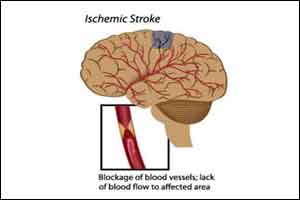- Home
- Editorial
- News
- Practice Guidelines
- Anesthesiology Guidelines
- Cancer Guidelines
- Cardiac Sciences Guidelines
- Critical Care Guidelines
- Dentistry Guidelines
- Dermatology Guidelines
- Diabetes and Endo Guidelines
- Diagnostics Guidelines
- ENT Guidelines
- Featured Practice Guidelines
- Gastroenterology Guidelines
- Geriatrics Guidelines
- Medicine Guidelines
- Nephrology Guidelines
- Neurosciences Guidelines
- Obs and Gynae Guidelines
- Ophthalmology Guidelines
- Orthopaedics Guidelines
- Paediatrics Guidelines
- Psychiatry Guidelines
- Pulmonology Guidelines
- Radiology Guidelines
- Surgery Guidelines
- Urology Guidelines
FDA clears New device for retrieving clots up to 24 hrs in Ischaemic Stroke

Trevo clot retrieval device was previously cleared to treat ischaemic stroke patients up to six hours after symptom onset by U.S. Food and Drug Administration.The regulatory agency has now cleared the use of device to treat these stroke patients up to 24 hours after symptom onset. It has expanding the device’s indication to a broader group of patients to reduce paralysis, speech difficulties and other stroke disabilities in addition to treatment with a medications that dissolves blood blots called tissue plasminogen activator (t-PA).
The device was previously cleared for use in patients six hours after symptom onset.A stroke is a serious medical condition that requires emergency care and can cause lasting brain damage, long-term disability or even death. According to the Centers for Disease Control and Prevention, stroke is the fifth leading cause of death in the U.S. and is a major cause of serious disability for adults. About 795,000 people in the U.S. have a stroke each year. Ischemic strokes represent about 87 percent of all strokes.
“Time is critical following the onset of stroke symptoms. Expanding the treatment window from 6 to 24 hours will significantly increase the number of stroke patients who may benefit from treatment,” said Carlos Peña, Ph.D., director of the division of neurological and physical medicine devices at the FDA’s Center for Devices and Radiological Health. “Health care providers and their patients now have better tools for treating stroke and potentially preventing long-term disability.”
The Trevo device was first cleared by the FDA in 2012 to remove a blood clot and restore blood flow in stroke patients who could not receive t-PA or for those patients who did not respond to t-PA therapy. In 2016, the FDA allowed expanded marketing of the device for certain patients in addition to treatment with t-PA if used within six hours of the onset of symptoms. Today’s expanded indication increases the amount of time that the device can be used once the symptoms are present.
Trevo is a clot removal device that is inserted through a catheter up into the blood vessel to the site of the blood clot. When the shaped section at the end of the device is fully expanded (up to three to six millimeters in diameter), it grips the clot, allowing the physician to retrieve the clot by pulling it back through the blood vessel along with the device for removal through a catheter or sheath.
The FDA evaluated data from a clinical trial comparing 107 patients treated with the Trevo device and medical management to 99 patients who had only medical management. About 48 percent of patients treated with the Trevo device were functionally independent (ranging from no symptoms to slight disability) three months after their stroke compared to 13 percent of patients who were not treated with the Trevo device.
Risks associated with using the Trevo device include a failure to retrieve the blood clot, embolization (blockage) to new territories in the brain, arterial dissections and vascular perforations, and access site complications at the femoral (thigh) artery entry point.
Trevo was reviewed through the premarket notification (510(k)) pathway. A 510(k) is a premarket submission made by device manufacturers to the FDA to demonstrate that the new device is substantially equivalent to a legally marketed predicate device. The FDA granted premarket clearance of the Trevo device to Concentric Medical Inc.

Disclaimer: This site is primarily intended for healthcare professionals. Any content/information on this website does not replace the advice of medical and/or health professionals and should not be construed as medical/diagnostic advice/endorsement or prescription. Use of this site is subject to our terms of use, privacy policy, advertisement policy. © 2020 Minerva Medical Treatment Pvt Ltd